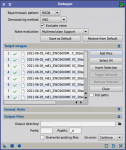chromesurfer
Member
I just upgraded to the new 2600MC and I'm having problems with processing when I include my master darks. I've used my manual pre-processing routine that worked fine for me with my ASI071MC and ASI1600MM, but when I get to the end of preprocessing (after debayering), I'm left with an image that has '0' RGB background values, which after stacking and integrating leaves me with nothing to work with. I've discovered by trial and error that if I leave the dark out of the calibration process, it seems to work fine using only bias and flats.
I thought maybe my process was off, so I tried putting the files through the new WBPP2 script, but I get the same results.
I've heard that maybe the darks are not needed for this camera due to low dark current, but I'm not sure how to validate other than it seems to work for me. Has anyone else experience issues in using this new camera?
Thanks!
I thought maybe my process was off, so I tried putting the files through the new WBPP2 script, but I get the same results.
I've heard that maybe the darks are not needed for this camera due to low dark current, but I'm not sure how to validate other than it seems to work for me. Has anyone else experience issues in using this new camera?
Thanks!






